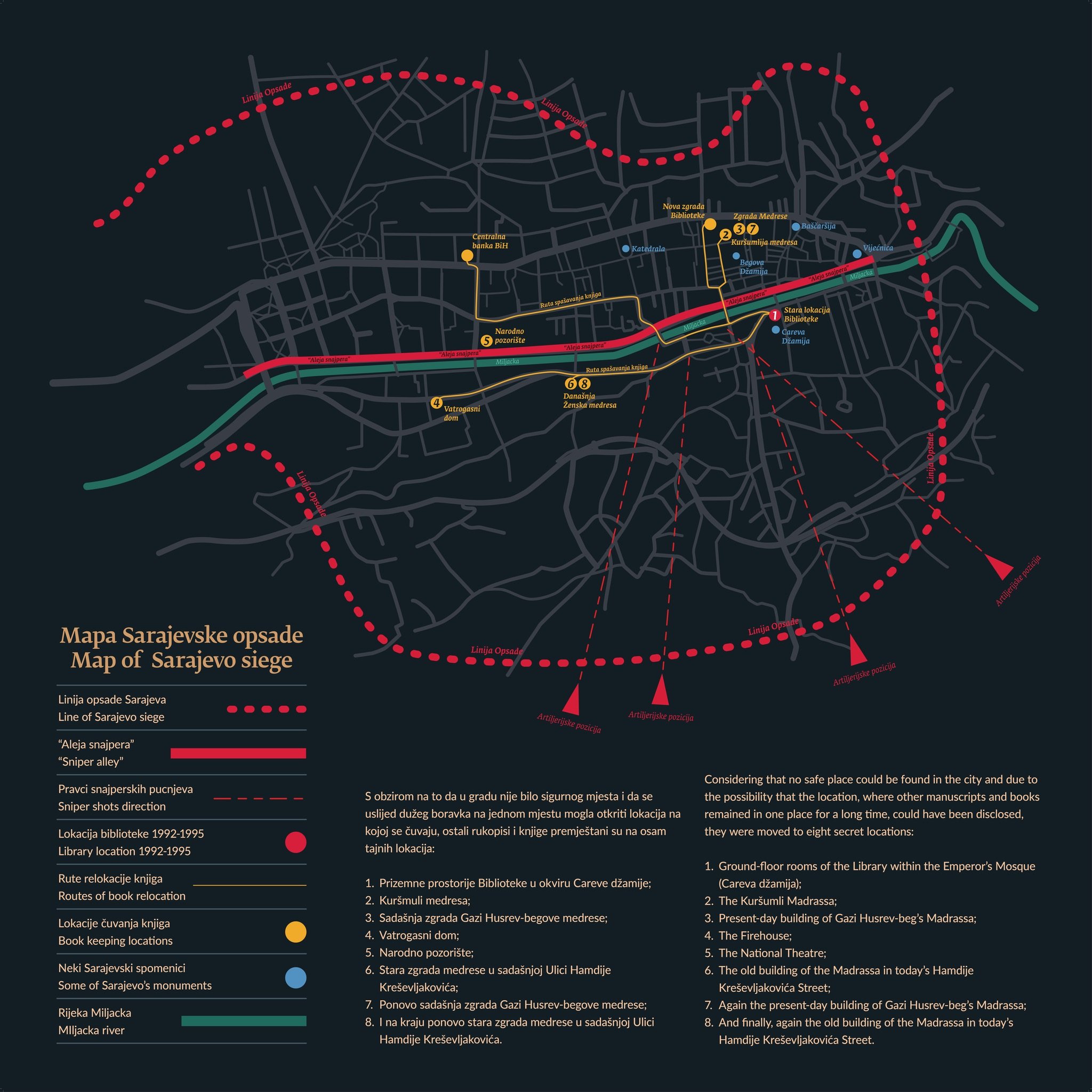
SHINING EXAMPLES OF PRESERVING WRITTEN HERITAGE
Author: Osman Lavić, MA, Gazi Husrev-beg Library in Sarajevo • Illustration: Relocation map of GHB books during the aggression against Bosnia and Herzegovina

In April 1941, when German troops bombed Sarajevo, a fire broke out in the courtyard of the Imperial Mosque, where the Gazi Husrev-beg Library was situated. Among other things, the fire ignited the roof of the Library. Upon noticing the fire from a window of the Seminary, the professor of the Franciscan Seminary Miroljub Pervan, PhD, alarmed firemen but they replied that they responded only to explicit orders by the Ban of the Drina Banate. The Banate administration was seated in the Konak, which was also very close to these buildings. Prof. Pervan went to the Konak premises, but did not find anybody there. From these premises, “in the name of Ban” he ordered the fire brigade to immediately go and fight fire, which was done and the Library was saved from the certain destruction.
During the Second World War the most valuable manuscripts were preventively moved from the Library and placed in the Gazi Husrev-beg Mosque. For this purpose, Handžić agreed with mutawalli (guardian) of the Gazi Husrev-beg Waqf to order wooden chests where the manuscripts were put and stored in the mosque (Archives of the GHL, no. 1/43).
At the beginning of the aggression on Bosnia and Herzegovina, in April 1992, at the initiative and under supervision of library director Mustafa Jahić, manuscripts, and then other books from the Library building of the time were relocated to a safer place in the city. About 500 selected manuscripts were stored in the vault of Privredna banka, where they remained until the end of the war. Since there was not a safe spot in Sarajevo and since the location of safekeeping could be discovered due to a longer keeping at one spot, relocation of other manuscripts was organized eight times during the war (ground floor of the old building of the Library, old building of the Kuršumlija madrasa, the present building of the Madrasa (Đulagin Dvor), Fire Station, National Theatre, old building of the Madrasa in the Hamdije Kreševljakovića Street, again the present building of the Madrasa and, finally, again in the old building of the Madrasa in Hamdije Kreševljakovića Street).
Brother Miroljub Jeftić, PhD
Actually, the Gazi Husrev-beg Library in Sarajevo holds about a hundred codices of manuscripts and over a thousand original documents in Oriental languages, which were endowed by daughters of the late Muhamed, son of Sadik and Begzada-hanuma, daughter of hadži Sabit-aga: Paša, Džehva and Emina-hanuma Đumišić from Banja Luka, as their parents’ wish. According to them, the family kept these manuscripts and archival material from generation to generation, in their family house in Banja Luka for almost 300 years (from the Battle at Banja Luka in 1737). As refugees during the latest aggression on BiH (1992-1995), they carried all these while they lived in the Republic of Croatia. Thanks to their dedication, the priceless cultural treasure and sources for studying the history of this family, Banja Luka and Bosnia and Herzegovina have been preserved and now stored at the safe place. As an example, we single out a codex with two, previously unknown manuscripts of Ibrahim, son of Muhamed, Abdussamed, Pruščak, written in Banja Luka in the first half of the 17th century (GHB, R-1028).
Relocation map of GHB books during the aggression against Bosnia and Herzegovina
References:
Archives of GHL, no. 1/43.
Kadić, Rešad, “Kako je sarajevski franjevac otac Pervan spasio dragocjenu Gazi Husrev-begovu knjižnicuˮ, Sarajevski novi list, year. I, no. 146, 1941, p. 5.
Jahić, Mustafa, Trajnost islamskog naslijeđa, Gazi Husrev-begova biblioteka, Sarajevo, 2019, p. 2.
